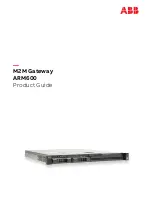
9/27/2017
LMU-3640 Hardware & Installation Guide - PULS Wiki
https://puls.calamp.com/wiki/LMU-3640_Hardware_%26_Installation_Guide
1/23
LMU-3640 Hardware & Installation Guide
LMU-3640™
Hardware and Installation Guide
IMPORTANT: DO NOT INSTALL OR USE THE SOFTWARE
OR DOCUMENTATION UNTIL YOU HAVE READ AND
AGREED TO THE LICENSE AGREEMENT AND REVIEWED
THE LIMITED WARRANTY AND REGULATORY
INFORMATION.
1
Introduction
Welcome to the LMU-3640™ Hardware and Installation Guide. This
manual is intended to give you information on the basic setup and
installation of the CalAmp LMU-3640™ product(s) including
hardware descriptions, environmental specifications, wireless network
overviews and device installation.
1.1
About This Manual
The LMU-3640™ is one of the most flexible economy mobile
tracking hardware products available. In order to accurately
describe the functionality of these units we have broken this
manual into the following sections:
System Overview
– A basic description of a
CalAmp LMU-3640™ based tracking system. This
includes a description of roles and responsibilities
of each of the CalAmp components as well as a
brief overview of the wireless data technologies
used by the LMU-3640™.
Hardware Overview
– Describes the physical
characteristics and interfaces of the LMU-3640™.
Installation and Verification
– Provides guidance
for the installation of the LMU-3640™ versions in a
vehicle and instructions on how to verify the
installation is performing adequately.
1.2
About The Reader
Contents
1
Introduction
1.1
About This Manual
1.2
About The Reader
1.3
About CalAmp
1.4
About the CalAmp Location Messaging Unit - LMU-3640™
2 System Overview
2.1
Overview
2.2
Component Descriptions
2.2.1
Backend Software
2.2.2
LMU Manager
2.2.3
LM Direct Server
2.2.4
Wireless Data Network
2.2.5 LMU-3640™
2.2.6 Host Device – Laptop/PDA or MDT
2.3
Wireless Data Primer
2.3.1
SMS (Short Message Service)
3 Hardware Overview
3.1 LMU-3640™
3.1.1
Environmental Specifications
3.1.2
Physical Specifications
3.2
Location Messaging Unit - LMU-3640™
3.3
LMU-3640™ Connectors
3.3.1
I/O Connector
3.3.2
VBUS Connector
3.3.3
Accessories
3.4
GPS Receiver
3.5
I/O Descriptions
3.5.1
3-Axis Accelerometer Input
3.5.2
Ignition and Inputs
3.5.3
Outputs
3.5.4
Status LEDs
4 Configuration and Activation
4.1
Quick Start - General Config
4.2
Activating LTE Using AT Commands
4.3
Auto provisioning of GSM or HSPA LMUs
4.4
Activating GSM or HSPA LMU using AT Commands
4.5
Preparing for Installation
4.6
Plan The Installation
4.6.1
Size and Placement of LMU Unit
4.6.2
Access to the SIM (Subscriber Identity Module) Card
4.6.3
Protection from Heat
4.6.4
Visibility of Diagnostic LEDs
4.6.5
Cable Length
4.6.6
Moisture and Weather Protection
4.6.7
Preventing Accidental or Unauthorized Modification
4.7
Installing the LMU in a Vehicle
4.7.1
Place the LMU unit in the vehicle.
4.7.2
Connect power, ignition, and ground.
4.7.3
Typical Connection Sequence
4.8
Installation Verification
4.8.1
Comm Verification
4.8.2
GPS Verification
4.8.3
Inbound Verification
4.8.4
Verification via SMS
In order to limit the size and scope of this manual, the following assumptions have been made about the reader.
1.
You are familiar with GPS concepts and terminology





























